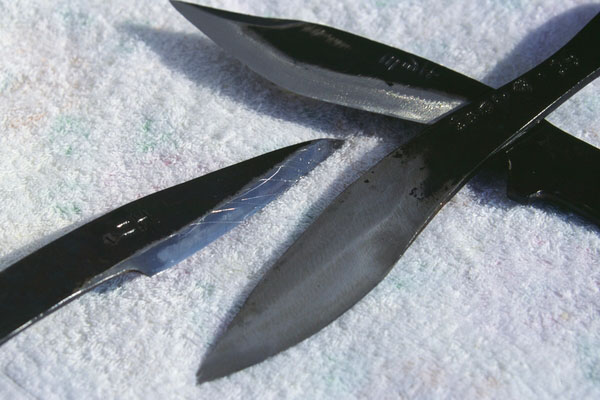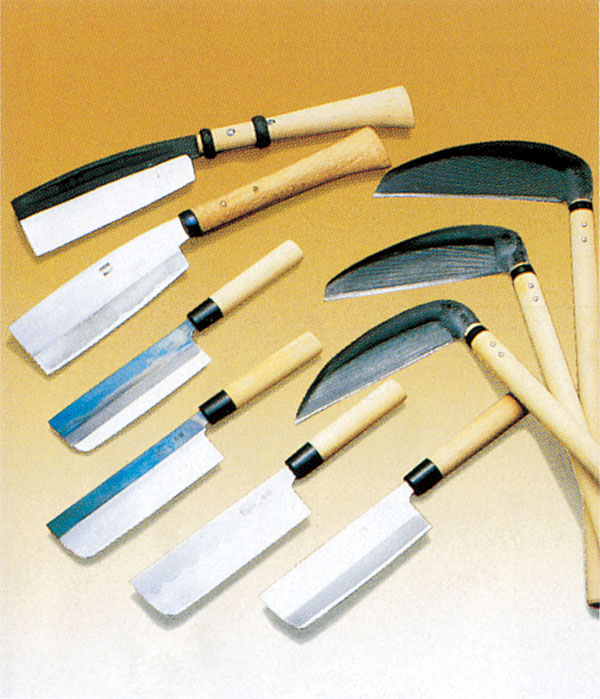 Photo:Shinshu・Nagano Prefecture Tourism Association
Photo:Shinshu・Nagano Prefecture Tourism Association
- Metal works
- Nagano
Shinshu Forged Blades Shinshu uchihamono
Useful crafts loved by artisans
Top-level craftsmanship in the thin blades
Description
What is Shinshu Forged Blades ?
Shinshu Forged Blades or Shinshu Uchihamono in Japanese, are metalworks produced around Nagano, Nagano prefecture. As this area was formerly a province called Shinano which was also called Shinshu, these blades are known under the name of "Shinshu Uchihamono". They are distinguished by their toughness, high sharpness and long lasting cutting quality which are the result of the skilled hand beating of each individual blade. The main products of Shinshu Uchihamono include farming implements such as sickles and hoes, forestry tools such as hatchets and axes, and kitchen knives. Their sickles and scythes are especially famous and highly evaluated. The reason for this is because the blade is processed to bring the cut grass back to the person cutting the grass, and it is also processed for the person to have good control even if the blade is a thin single-edged blade which is light and easy to use. The technical skills for producing sickles are said to have developed in the beginning of the 19th century. Shinshu Uchihamono continue to be made by the blacksmiths that succeeded these techniques.
History

The origins of Shinshu Uchihamono are thought to be connected to the battle of Kawanakajima when blacksmiths who moved to Nagano city to maintain the arms and swords of samurai involved in the conflict stayed on and taught the local people the forging techniques during the Sengoku period, in the middle of the 16th century. The forging techniques contributed to the production of farming implements and forestry tools, and later were handed down and evolved over the generations.
Furthermore, since this area was located along the Hokkokukaido Road (a road that branched off the Nakasendo Road, one of the main roads that led to Tokyo, from around current Karuizawa in Nagano and lead to Naoetsu in Niigata), it was easy to bring iron and steel produced in the Sanin area (southwest region of the main island of Japan) via Naoetsu port in Niigata. In addition, the area was blessed with an abundance of pine woods providing the raw materials for pine charcoal which is softer than regular charcoal, and ideally suited for forging the thin blades of Shinshu Uchihamono. The road that brought in the raw materials, also served to distribute the finished blades across the whole country.
In the first half of the 19th century, one blacksmith making grass sickles invented the characteristic techniques of Shinshu sickles, while another blacksmith refined the double-edged blade to a thin single-edged blade. These two kinds of sickles are the original styles of Shinshu sickles. Later, the techniques of blade production were further developed and were passed down through the generations to the current Shinshu Uchihamono artisans.
General Production Process
- 1. Forge welding
After preparing the steel and iron base, the steel for the edge of blade and the iron base are joined by forge welding. Forge welding is joining different types of metal together by heating to a high temperature and then hammering. The steel is usually thinner than the iron base; for example an iron piece measuring 2 millimeters in thickness is joined with an iron base measuring 9 millimeters in thickness.
- 2. Curving the tang
The tang is a part sticking out to be fitted to the handle of the sickle. The part to become the tang is beaten and curved.
- 3. Stretching the tang
The curved tang part is beaten and stretched.
- 4. Stretching the blade
The blade is carefully beaten and stretched to a rough sickle shape.
- 5. Adjusting the size
The edge of the blade is adjusted to size.
- 6. Making the tang
The tang part is adjusted.
- 7. Rough beating
After the sickle is heated in a forge at about 700°C, it is beaten with different types of hammers until the flat part of the blade has an even thickness. This requires a great deal of skill.
- 8. Rough polishing
The surface of the sickle is cleaned by removing iron oxide and slag.
- 9. Engraving
Trademarks and quality indication marks are engraved onto the metal.
- 10. Smoothing
Smoothing gives toughness to the blade, a characteristic of Shinshu Uchihamono; the sickle is heated in a forge at about 500°C, and then beaten with a hand hammer to flatten. After smoothing, shibazuke and tsuri, which are features of the Shinshu sickle, are processed. Shibazuke angles the sickle body and tang so that the cut grass comes closer to the person’s hand, and tsuri curves the blade surface inward so that the person cutting grass doesn’t miss their aim even if the blade is thin.
- 11. Sharpening with a second-cut grindstone
The steel part is sharpened on a second-cut grindstone.
- 12. Quenching
After the sickle is coated with mud to ensure even cooling during the tempering process, it is heated and kept at about 780°C, and plunged into a water tank to quickly cool. Quenching changes and hardens the steel structure. It is said that by hardening, “the soul is put into the blade.”
- 13. Tempering
As the blade gets nicked if it is too hard, this process makes the steel tough and durable to prevent nicking and helps to keep a sharp edge.
- 14. Fixing distortions
Iron and steel contract and expand at different rates, which may result in warping and curving after quenching. Any distortions are fixed.
- 15. Polishing and burnishing
The blade is polished with a buffing cloth.
- 16. Rust prevention
The blade is coated with varnish or camellia oil to prevent rust.
- 17. Mounting on the handle
The blade of the sickle is mounted on the handle.
Where to Buy & More Information
Iiyama Dento Sangyo Kaikan
-
Address
-
Tel.+81-269-62-4019
-
ClosedMondays (open if Monday is holiday and closed the next day), December 29 to January 3
-
Business Hours9am to 5pm (shorter business hours from the middle of December to the middle of March)
-
Website
See more Metal works
- Nambu ironware
- Takaoka copperware
- Yamagata cast iron
- Sakai cutlery
- Tokyo silverware
- Echizen cutlery
- Osaka naniwa pewterware
- Tosa cutlery
- Tsubame-tsuiki copperware
- Shinshu Forged Blades
- Banshu-miki cutlery
- Higo inlays
- Echigo-sanjo cutlery
- Echigo-yoita cutlery
- Chiba Artisan Tools
- Tokyo antimony craft































































































































































































































































































